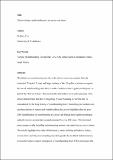Files in this item
Historicizing waterboarding as a severe torture norm
Item metadata
| dc.contributor.author | Cox, Rory | |
| dc.date.accessioned | 2018-09-24T11:50:49Z | |
| dc.date.available | 2018-09-24T11:50:49Z | |
| dc.date.issued | 2018-12 | |
| dc.identifier | 252430867 | |
| dc.identifier | e2483e4b-323e-440b-99ec-e7f304b9c957 | |
| dc.identifier | 85058311186 | |
| dc.identifier | 000453212400006 | |
| dc.identifier.citation | Cox , R 2018 , ' Historicizing waterboarding as a severe torture norm ' , International Relations , vol. 32 , no. 4 , pp. 488-512 . https://doi.org/10.1177/0047117818774396 | en |
| dc.identifier.issn | 0047-1178 | |
| dc.identifier.other | ORCID: /0000-0002-5380-6230/work/73293323 | |
| dc.identifier.uri | https://hdl.handle.net/10023/16068 | |
| dc.description.abstract | The debate on waterboarding and the wider debate on torture remains fiercely contested. President Trump and large sections of the US public continue to support the use of waterboarding and other so-called 'enhanced interrogation techniques' as part of the 'War on Terror', thus putting the anti-torture norm under pressure. This article demonstrates that the re-imagining of waterboarding as 'torture-lite' is contradicted by the long history of waterboarding itself. Examining pre-modern uses and descriptions of torture and waterboarding, this article highlights that the post-2001 identification of waterboarding as a relatively benign interrogation technique radically inverts a norm that has predominated for over 600 years. This historical norm unequivocally identifies waterboarding not only as torture but as severe torture. The article highlights the value of historically contextualizing attitudes to torture, reviews how and why waterboarding was downgraded by the Bush Administration, reveals the earliest explicit description of waterboarding from 1384, and argues that the twenty-first-century re-imagining of waterboarding as torture-lite is indicative of the fragility of the anti-torture norm. | |
| dc.format.extent | 25 | |
| dc.format.extent | 618953 | |
| dc.language.iso | eng | |
| dc.relation.ispartof | International Relations | en |
| dc.subject | Anti-torture norm | en |
| dc.subject | CIA | en |
| dc.subject | Comparative ethics | en |
| dc.subject | Legal history | en |
| dc.subject | Torture | en |
| dc.subject | Torture-lite | en |
| dc.subject | Waterboarding | en |
| dc.subject | JZ International relations | en |
| dc.subject | T-NDAS | en |
| dc.subject | BDC | en |
| dc.subject | SDG 16 - Peace, Justice and Strong Institutions | en |
| dc.subject.lcc | JZ | en |
| dc.title | Historicizing waterboarding as a severe torture norm | en |
| dc.type | Journal article | en |
| dc.contributor.institution | University of St Andrews. School of History | en |
| dc.contributor.institution | University of St Andrews. Institute of Legal and Constitutional Research | en |
| dc.contributor.institution | University of St Andrews. St Andrews Institute of Medieval Studies | en |
| dc.identifier.doi | https://doi.org/10.1177/0047117818774396 | |
| dc.description.status | Peer reviewed | en |
| dc.date.embargoedUntil | 2018-09-20 |
This item appears in the following Collection(s)
Items in the St Andrews Research Repository are protected by copyright, with all rights reserved, unless otherwise indicated.

